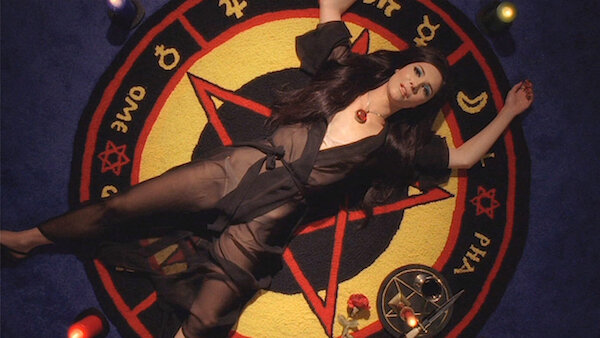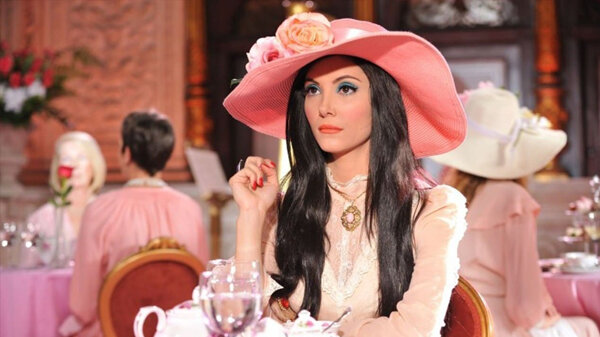Film history overflows with phallocentric imagery, in an industry often governed by the male gaze. But the tide is turning - and has been vividly since Anna Biller’s campy, mystical yonic drama The Love Witch. Eve Froude explores the specific imagery of female anatomy in all its forms.
In a discussion on her 2016 film The Love Witch, filmmaker Anna Biller wrote that she thinks of her work as “a horror movie designed to scare men, in the sense that men are the victims and they are not empowered”. The Japanese-American director goes on to state that the film will scare men because of its refusal to stifle girlishness. “[I]t contains scenes of women talking together obsessively about love, in rarefied female environments. I think of lace curtains and dollies and tea accessories, for example, as scaring men.”
Biller has a long history as a filmmaker. Her first short film, Three Examples of Myself as Queen, a film in which Biller starred, produced, wrote, edited, and acted as costume designer for, was first screened in 1994. Three Examples, a highly stylised feminist Arabian Nights musical involving a coquettish woman’s self-liberation (described by Biller as “Sandra Dee meets Madonna”), channels the same themes as explored 20 years later in The Love Witch: a study of sexual pleasure, sovereignty, and a challenge to the classical ’60s sexpolitation genre. It is often easy to point out obvious sexual imagery in film history – phallic symbolism is everywhere, from guns to knives to the erect chest-buster creatures in Ridley Scott’s Alien. Yet it’s harder to define the phallic’s sexual counterpart: the yonic, or to use the language of The Love Witch, the woman’s “earthly body, the spiritual essence, the womb”. The yonic is the vulvic embedded symbol; caves, blooming flowers, a bloody heart, shells and the rippling sea, ripe fruits, the folds of fabric, or even iconography of the Virgin Mary, hands outstretched and welcoming. As Tilde Fredholm states, the cinematic yonic “fill[s] the screen; we receive them in their muteness; they make an impression”. Upon countless re-watches of Biller’s film, it is impossible to ignore the yonic emblems within her work, and how through the privileging of vulvic imagery, The Love Witch fights against patriarchal structures of the sexualised female body. The Love Witch calls out the symbols of sexual imagery, documenting their usage from the perspective of the murderous and lovesick protagonist Elaine (Samantha Robinson) as well as through the film’s props. As Laura Mulvey understands phallic figurations to “demonstrate the way the unconscious of patriarchal society has structured film form”, Biller redirects the viewer’s gaze toward the sexual nexus of horror and tragedy; the filmmaker’s ability to inspire fear of female sexuality.
The Love Witch begins with Elaine driving in her car, the film title appearing directly over her eye as the penetrating score of violins and soft drum beats play. From this, it is immediately clear that this is a film about vision. For the most part, Robinson’s eyes are brushed sky blue, with bold, sweeping eyeliner. Elaine is never shown without her striking make-up, or in anything less than detailed costuming. Elaine’s first outfit, a blood-red mini dress that matches her car, shoes, lips, and suitcases, embodies and engulfs her like an open wound come to life. Elaine-as-wound bleeds into every scene of the film, ultimately into every character. She is the sexual being, the ultimate fantasy, the made-up woman, the love witch. And she’ll love you to death.
Aesthetics play a key role in the search for yonic symbolism and vulvic milieu, fusing with the mise-en-scène to create a setting enamoured with sexuality. Biller wrote that when collaborating with Robinson to construct the costuming for Elaine (Biller was costume designer and producer on The Love Witch, as well as director and writer), that it was like “a little girl playing dress up. [Robinson] was both inside of herself and outside looking at herself, as most women are who have created an image of femininity for the world”. I am reminded of John Berger, “Women watch themselves being looked at”. Of Margaret Atwood’s The Robber Bride declaring, “You are a woman with a man inside watching a woman. You are your own voyeur”. Or more recently, Eliza Scanlen of Sharp Objects declaring “You just let [boys] do stuff to you. When you let them do it to you, you’re really doing it to them”. What is the acceptance of heterosexuality on screen, if not the embrace of this voyeurism, of constructed femininity?
Yet Biller contests this. The Love Witch revels in its campiness, of its over-indulgence in love and heterosexual passions. An early scene between Elaine and Trish (Laura Waddell) has the two women arguing about male attention over tea and cake, which neither of them consume. “What do men want?” asks Trish. Elaine replies, “To give them total freedom in whatever they wanna do or be”. The setting itself is a uterine homage – the women’s only tearoom with its blush pink walls, salmon chairs, clothing and accessories the colour of blood and pepto-bismol – the tearoom, the setting of consumption, revels in girlishness and pink claustrophobia. Elaine speaks of giving men their “fantasy”, and through this Biller confronts the labour of female performance, of desire as something to give. In Biller’s own words, “The Love Witch is about love, and is thus a tragedy”.
In another scene, after a one-night stand resulting in death, Biller demonstrates just how much Elaine is willing to give away. After she gives her lover, Wayne (Jeffrey Vincent Parise) “the rainbow” – that is, her body and sexual gratification – Elaine first cooks breakfast for him, deals her tarot deck, and finds him dead in bed. Robinson’s character then urinates into a jar, removes her bloody tampon and places it, alongside sprigs of rosemary, inside and over the shallow grave in which Elaine has dug. Food, magic, death, bodily expulsion, dirt. This is the performed grieving woman on screen, the labour of her lover’s burial rites. During this ritual of death, Elaine’s voiceover laments over the loss of her cat. The cat has classic connotations and connections to the feminine, stereotypically depicted as the female witch’s familiar, an animal of protection. Having lost this familiar, alongside her “rainbow” (Elaine lines all her clothes with rainbow fabric, and during the burial turns her dress inside out and gives it to the grave), and thereby her sex, Elaine is now lacking because she has nothing left to give away. If, as stated by Trish, Elaine is “brainwashed by the patriarchy, [her] self-worth wrapped up in pleasing a man”, and this man is now dead, who is Elaine now? Biller demonstrates this violent cycle of self-worth in conjunction to man, the next scene shows Robinson in the bath, a homemade baptism in which her character can be born anew, reconfigure her femininity in terms of yielding to male desire.
If Elaine cannot exist without male attention, what happens when that attention disappears? Elaine simply continues. Biller refuses to reduce women to merely their connection to men. In fact, every character within the film exists only in relation to Elaine, regardless of her need for love, disproving Trish’s claims.
When her final lover must die, Elaine stabs his chest, she sits, alone, victorious and blood-soaked. The witch will not burn. Throughout the film, her character is shown tenderly painting an image of a woman holding a heart, a male body lying next to her, open, wounded and bloody, a warning of what is to come. This heart is the ultimate yonic symbol, pulsing and red, and this final scene of the film presents a hybridised version of Elaine-as-painting, as an object of female passion and labour. When there is no more room for accommodating phallocentrism, Biller suggests that one must embody the yonic.
Eve (@evefroude) is a writer currently based in Cardiff. She writes primarily on female trauma, ghosts, and the ocean. In September, she will begin her MA in Film & Literature at the University of York.
Our ANNA BILLER t-shirt is available to purchase here. Proceeds go towards paying our writers and supporting female-led film projects.




